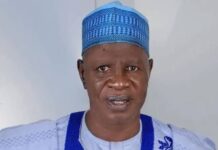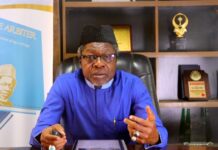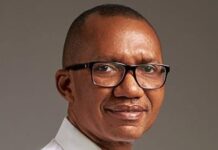BreakThrough
As a corollary to last week’s article, readers can see that the advent of nuclear technology in the fourth decade of twentieth century and its dreadful impacts on humanity made the world a fearful planet to live. Uncertainty and anxiety were the order of the day during the “Cold War” era and people were just living by the day. What could have been the effect, if any of the opposing forces fire missiles carrying nuclear armament on each other? Among the anti-nuclear movements, women groups fought gallantly through peaceful demonstrations that forced the world to initiate Nuclear Non-Proliferation Treaty (NPT).
Read also: ABU Zaria Creates Waves in Use of Nuclear Technology (1), by Professor MK Othman
Today, the world is safer and pleasurable to live, thanks to diligence and perseverance of women. We were made to look for a better and more beneficial ways of using the nuclear technology. It is crystal clear that a nuclear attack anywhere will ultimately affect the global economy negatively no matter the distance from where the attack occurs. This understanding underscores the importance of the way Nigeria is handling the only certified nuclear reactor in ABU Zaria.
Nigeria has been a signatory to all treaties and additional protocols on the safe, secure and peaceful use of nuclear energy including the Non Proliferation Treaty (NPT). Recently, the country played a key role in the ratification of the Pelindaba treaty, which created a Nuclear Weapons Free Zone (NWFZ) in Africa. In pursuing the goal of the treaty, Nigeria eventually converted the highly enriched uranium (HEU) nuclear reactor to fuel containing low-enriched uranium (LEU). This feat makes Nigeria a Nuclear weapons free country, a feat that was achieved with full cooperation and active participation of the nuclear scientists of Ahmadu Bello University Zaria. Now back to the questions posed in the first of this article; how was the conversion from highly enriched uranium to low enriched uranium achieved? Was the conversion necessary?
At least four countries; USA, Russia, China and Czech Republic in addition to International Atomic Energy Agency (IAEA) were involved in the conversion of Nigeria’s reactors. Nigeria was supported technically and financially to make the conversion and make the country a nuclear friendly nation. IAEA played a role of a regulator, which ensured the importation of the material from China to Nigeria was properly done in accordance with the requirements of international trade. This was to Nigeria from being accused of importing nuclear weapons illegally. The agency gave Nigeria the required license, transport criteria and safety requirements to transport the material through the air routes. People from Czech Republic provided the tools required in the manipulation of and installation of the new core while the Russians provided the platform for movement of the material across the world. They transported the material from Nigeria to China and from China to Nigeria because they have the certificate to move any nuclear material across the globe. They assisted in handling the material to ensure its safety and that radiation protection measures were properly and strictly observed during the transition.
United States of America supported Nigeria financially when it became clear that Nigeria couldn’t afford required resources to fabricate new core, which was in millions of dollars USA provided the needed financial resources for the materials to be fabricated by the Chinese and transported to Nigeria. The Chinese played the technical role of doing the fabrication for the fuel that would certify the requirement of the Nigerian reactor. Before this conversion was done, the process took almost ten years as explained by the Executive Director of the Center for Energy and Training, Prof. Yusuf Ahmed to Daily Trust, a national newspaper “There are challenges in searching for the required fuel that can give you the required power.
It took the international community more than 10 years in the selection of the required fuel, until we arrived at the fuel that can deliver the required power. For instance, our reactor used to be 30kW with HEU and now it is 34kW with LEU, so we have upgraded the power. While you are trying to downgrade and blend the fuel content, you are also upgrading the power. This means that the capacity to do the work was more than what the reactor was before. So, while non-technical personnel would say the reactor was reduced in terms of fuel usage, technical personnel would tell you the reactor was upgraded”
At the university’s Center of Energy and Training, two project management teams were constituted for the conversion activities and while the Convert Team worked closely with the Argonne National Laboratory, USA, for all activities related to the new LEU core including its transportation from Beijing, China to Zaria, Nigeria and loading into the reactor, “the Remove Team in conjunction with Idaho National Laboratory was saddled with responsibility of removing the old HEU core and its return to China.”
The HEU conversion for Nigeria was necessitated by world commitment to reduce nuclear risk. Security and vulnerabilities associated with nuclear fuel cycle and HEU stockpiles in civilian facilities are realities of nuclear security threat. Furthermore, there is need to integrate nuclear security with nuclear safety in the wake of the Fukushima disaster as a way to encourage the nuclear renaissance. Prof Ahmed further explained “In civilian research facilities, we need to have materials that are not of weapons-grade and incidentally, in the nuclear industry, if you enrich uranium to a certain percentage or more than 20% it becomes a weapon-grade material and in Nigeria our research reactor is powered by fuel containing HEU (90.2%) above the 20% approved limit. Internationally, weapon-grade material should best be in military facilities and not civilian related. So, to conform to global threat reduction initiatives, Nigeria, had signed the Treaty on the Non-Proliferation of Nuclear Weapons and all other conventions related to that and in view of that, Nigeria became a partner to the IAEA. This project started in 2005 when the IAEA constituted a research project to find alternative fuels for reactors of this nature that have HEU fuel as their core so as to get LEU for the core to serve all other parameters on what the reactor will do with the HEU”.
The Centre has over the years successfully used peaceful applications of Nuclear Science and Technology to diverse sectors of the Nigerian economy. These include agriculture, water resource management, oil and gas industry and other industries, and the solid mineral sectors,
One of the uses of nuclear technology at CERT is soil fertility mapping in all parts of Nigeria. The mapping indicates different soil nutrients quantitatively and qualitatively. This information on soil map is a sine qua non to an excellent plan for agriculture in the country. Currently, there is indiscriminate fertilizer application by farmers nationwide. However, the use of the soil fertility map could be a fantabulous tool for guidance of farmers on the types and quantity of fertilizer needed on their farms. It could be more efficient and certainly more effective, if soils are evaluated to know their nutrient requirements. Similarly, the nuclear technology is being used for water resources management.
The center can carry out groundwater evaluation to determine the age of water, its recharge and discharge rate, and thus, the quantity and how best to manage the water body. Again, the center is one of the very few facilities that render radiation services for all radiation workers in the country. These include people in the hospitals using x-ray machines and also those in the oil industry using radiation sources. In health sector, radiation sources are used for both diagnosis and therapy. The center trained several people who could evaluate radiation doses for the treatment of patients and also for monitoring of workers in hospital.
In similar vein, nuclear technology at CERT, if adequately utilized, can drastically reduce the recurring problems leading to the shutting down of the country’s refineries. There is portable equipment that can be used to troubleshoot at refineries to identify malfunctioning column in the refinery using radiation sources. It scan through the facility, find the problem tray and go directly to where you have the problem, repair it and go back to operations with a shorter shut down period. This technology is a readily available option to what obtains today where refineries are usually shut down for a very long time to fix problems. Without this technology, refineries have to be shut down and then check tray- by- tray to detect where the problem is, address it and then resume production for which very valuable time are wasted.
In conclusion, ABU Zaria through its famous CERT can render several services to various university teaching hospitals and research institutes using radioactive substances and the only Nigeria’s Miniature Neutron Source Reactors (MNSR). Are the stakeholders taking advantage of this valuable asset and services at ABU Zaria? When will the nation address the recurrent and annoying electricity problem in the country using nuclear technology? The ball is in the court Nigerian leaders; perhaps President Buhari will focus his attention on the low hanging fruit at this second tenure.
Professor Othman is the Executive Director of National Agricultural Extension and Research Liaison Services (NAERLS), ABU Zaria.
Follow the Neptune Prime channel on WhatsApp:
Do you have breaking news, interview request, opinion, suggestion, or want your event covered? Email us at neptuneprime2233@gmail.com




